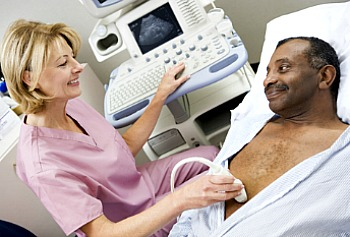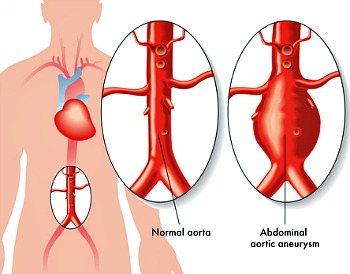Abdominal Aortic Aneurism Screening
Your Questions Answered.
What is an Abdominal Aortic Aneurysm?
An abdominal aortic aneurysm is the enlargement, or swelling, of the aorta, the main blood vessel that delivers blood to the abdomen, pelvis, and legs. This condition commonly affects men over the age of 65, with only one-third of diagnosed cases of abdominal aortic aneurysm affecting women.
Between 2005 and 2012, more
than 29.000 patients underwent surgery to repair intact abdominal aortic
aneurysms. Catching an abdominal aortic aneurysm before it ruptures is crucial,
as 80% of patients with ruptured aneurysms die (many of them on the way to the
hospital). Surgery survival rate for ruptured abdominal aortic aneurysms is 50%. Reports estimate that 34 in every 100.000 people die of AAA per year in the UK.
What is the Abdominal Aortic Aneurysm Screening?
Abdominal aortic aneurysm screening is a simple test wherein an ultrasound scan checks for the presence of an abnormality in the aorta (the big blood vessel that runs from the heart through the abdomen). Specifically, the test checks for ballooning of the aorta. The screening is completely pain free. It does not require needles, incisions, or invasive procedures. The entire process lasts between 5 to 10 minutes and it can save your life.
Who Should Be Screened?
Men 65 year of age and older are prime candidates for abdominal aortic aneurysm
screening, particularly men who were or are smokers. First-degree relatives of
anyone with AAA is eligible for a screening ultrasound scan from age 55 on, as
close relatives have an increased chance of developing AAA themselves. Though abdominal
aortic aneurysms are less common in women, any woman over the age of 65 with
family history of AAA should be screened for disease.
What Is AAA Screening Like?
On arriving for the screening, patients will confirm their identity and answer questions about their overall health. Medical staff provides information to ensure patients understand the purpose and process of abdominal aortic aneurysm screening.
While the patient does not need to fully undress, the patient will probably want to remove his or her shirt. The ultrasound tech or doctor will rub a clear gel on the patient’s abdomen and move a convex-shaped ultrasound probe over the skin.
Ultrasounds work by sending and receiving sound
waves through the body. Those waves form images and help doctors to see what’s
going on in the human body. In this case, the doctor or ultrasound technician
will be looking to identify any localized ballooning or dilation of the aorta.
Results are provided to patients instantly. Either there will be no abdominal
aortic aneurysm seen (normal), a small aneurysm seen (under 5.5cm in diameter),
or a large aneurysm (over 5.5cm in diameter)
The Multicentre Aneurysm Screening Study
In November 2002, The Lancet Medical Journal published a study of 67.800 men ages 65 and older, with risk factors for abdominal aortic aneurysm were selected and divided into two groups. The first group had a pain-free ultrasound scan of their abdomen. The members of the second group had no scans at all.
Within four years, those who had the abdominal aortic aneurysm scan had a 52% reduction in mortality rate, compared to those not screened.
Known globally as the Multicentre Aneurysm Screening Study (MASS), this study, along with two others like it, demonstrates that screening for the presence of abdominal aortic aneurysm saves lives.
Several countries, including the UK and US, now
have a National Screening Program for Abdominal Aortic Aneurysm (AAA). In the
UK, the organisation designated to carry out this program is called the NHS
Abdominal Aortic Aneurysm Screening Program (NAAASP). They screen about 300,000
men annually.
What Screening Results Mean

An abdominal aortic aneurysm is said to be present, when the diameter of the aorta increases by more than 50% of the expected diameter.
At the point where the aorta enters the abdomen around the level of the eleventh rib, the size of the aorta there is about 2.5cm. This narrows off progressively to 2.1cm just above the kidneys and 1.5cm just before the aorta divides into two below the level of the umbilicus.
95% of abdominal aortic aneurysms occur just
below the level of the kidney. Any localized ballooning of the aorta more
than 3cm in total diameter is diagnosed as an aneurysm of the abdominal aorta.
Normal Scan
The abdominal aorta measures less than 3cm in diameter in a normal scan. Most people will fall into this category and their health care provider may recommend they come back for another scan in five years.
Small Aneurysm Seen
A small aneurysm is an abdominal aneurysm that measures between 3 and 5.5cm. Aneurysms expand at a rate of about 2 to 3mm per year. In those with small aneurysms, the health care provider will put a plan in place to schedule the patient for annual AAA scans to monitor the growth rate of the aneurysm.
In most cases, doctors can link small abdominal aortic aneurysms to other health problems such as high blood pressure or poor circulation. A growing body of evidence suggests the use of Statins to treat small aortic aneurysm may reduce the rate of expansion of aneurysms.
Large Aneurysm Seen
Aneurysms that exceed 5.5cm in size are considered large aneurysms. It is only a very few number of people who undergo scanning that are found to have large aneurysm. Risks of the aneurysm rupturing increase in proportion to size of the aneurysm.
- 5.0 - 5.9 cm in diameter have 3 – 15% chance of rupturing
- 6.0 - 6.9 cm in diameter have 10 – 20%
- 7.0 - 7.9 cm in diameter have 20 – 40%
- 8.0 cm in diameter or greater have 30 – 50%
Risks
Associated with Screening for Abdominal Aortic Aneurysm
Minimal risks are associated with the actual AAA screening process, or
with surgical repair of aneurysms. In 1 in 10.000 cases, the patient will not
survive the surgery. The benefits from an abdominal aortic aneurysm screening
far outweigh the risk. In the UK, experts estimate 2.000 deaths are prevented every year through
screening.
Real Life Case Of Benefit From Screening
Sheila Arrington, Founder of Aneurysm Outreach US, promoted free abdominal aortic aneurism screening across the USA for many many years and helped saved lives.
Here is a real life case report of one of those who benefited from screening, as presented on WWL-TV - New Orleans, LA.
If you or your loved one have equally benefited from screening, or have any question on this topic, please feel free to share your thoughts here using the box below.
If you live in the USA, you can now get a one-time abdominal aortic aneurism
screening done under your Preventative Visit on your Medicare Part B (Medical
Insurance) for free as a senior.
Abdominal Aortic Aneurysm Screening: Share Your Story!
Have you or your loved one suffered with AAA? Did you find out from screening? Do you have a great story about abdominal aortic aneurysm? Or just have a query on AAA screening? Share it! Help others who have this condition realize that they are not alone. Tell us your aneurysm story here.
Be a detailed as possible. Post your thoughts here.
What Other Visitors Have Said
Click below to see contributions from other visitors to this page...
I survived an AAA rupture 




It happened in January 2001 when I was 72 years old.
No warning. I was at work 30 miles from home. Symptoms were nausea and diarrhea. I drove …
|
Help Keep This Site Going |

Return To Home Page From Abdominal Aortic Aneurism Screening Page




